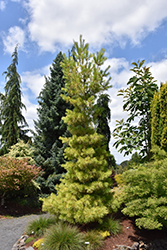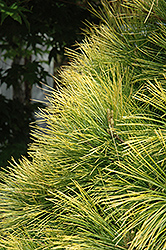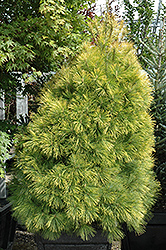It's all about ...
plants

Louie Eastern White Pine
Pinus strobus 'Louie'
Height: 25 feet
Spread: 12 feet
Sunlight:
![]()
Hardiness Zone: 3a
Other Names: Eastern White Pine
Description:
This broad upright evergreen has vibrant golden-yellow long thin needles that remain that way all year round; a strong vigorous selection for a dramatic landscape accent; best planted in full sun
Ornamental Features
Louie Eastern White Pine is primarily valued in the landscape for its distinctively pyramidal habit of growth. It has attractive gold evergreen foliage. The needles are highly ornamental and remain gold throughout the winter.
Landscape Attributes
Louie Eastern White Pine is a dense evergreen tree with a strong central leader and a distinctive and refined pyramidal form. Its relatively fine texture sets it apart from other landscape plants with less refined foliage.
This tree will require occasional maintenance and upkeep. When pruning is necessary, it is recommended to only trim back the new growth of the current season, other than to remove any dieback. Gardeners should be aware of the following characteristic(s) that may warrant special consideration;
- Insects
- Disease
Louie Eastern White Pine is recommended for the following landscape applications;
- Accent
- Mass Planting
Planting & Growing
Louie Eastern White Pine will grow to be about 25 feet tall at maturity, with a spread of 12 feet. It has a low canopy with a typical clearance of 3 feet from the ground, and is suitable for planting under power lines. It grows at a medium rate, and under ideal conditions can be expected to live for 80 years or more.
This tree should only be grown in full sunlight. It is very adaptable to both dry and moist growing conditions, but will not tolerate any standing water. It is not particular as to soil type, but has a definite preference for acidic soils, and is subject to chlorosis (yellowing) of the foliage in alkaline soils. It is quite intolerant of urban pollution, therefore inner city or urban streetside plantings are best avoided, and will benefit from being planted in a relatively sheltered location. This is a selection of a native North American species.


